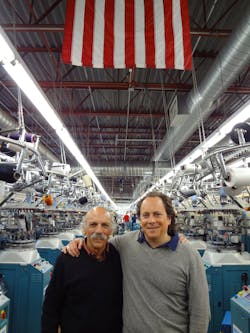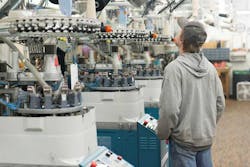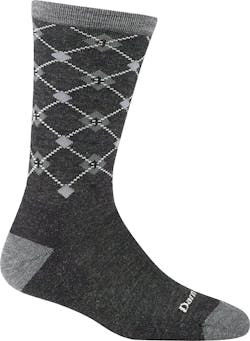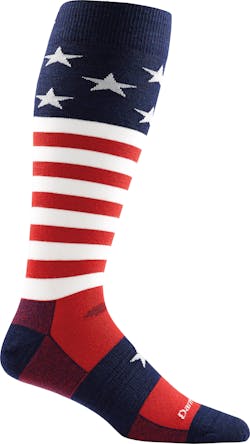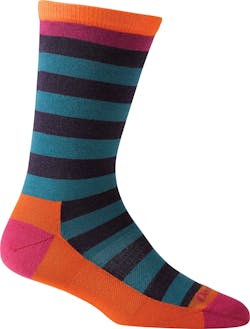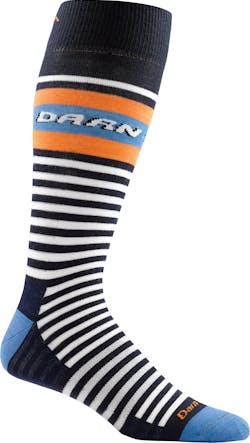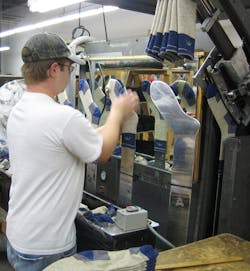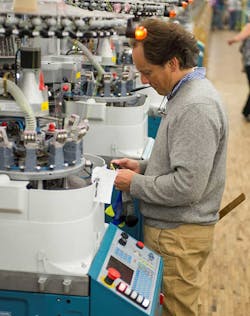How an American Sock Manufacturer Battled Its Way Back from Bankruptcy to Growth
When the last giant textile mills along the Merrimac River in New England shut down, hosiery was not far behind. The death of brick factories with names like Appleton, Lawrence, Coolidge and Cabot -– remember that name, Cabot -- marked the end of a one-hundred-fifty-year run of seemingly limitless U.S. innovation and profit dominance.
The human cost of lost livelihoods and hollowed-out towns was a pain suffered in city after city as first labor, wage and speed-up conflicts, followed by outsourcing, gouged big holes in the U.S.’ industrial fabric -- and forever changed the formula for success.
Earlier, the 1814 Boston Manufacturing Company’s prototype Waltham, Mass., mill, engineered by Frances Cabot Lowell and Paul Moody, succeeded on the strength of scale -– deeper waterfalls, more Yankee mill girls, then more workers from Ireland and Europe, more machines, bigger factories and, finally, complete process integration. The stockholders at the time were ecstatic as they, like the mill owners, saw cash endlessly pouring off rows of looms.
Small and, later, big brick mills provided local work for small towns and enormous profits for stockholders, but like so many other victims of outsourcing, hosiery manufacturing in the U.S. couldn’t keep up.
Like the textile mills before them, more and faster machines, economies of scale, fewer workers and home-grown innovation were just not enough to stem the outflow of this U.S. high-volume, low-margin business to cheap labor areas, first to the American South, then the Far East.
Like so many other U.S. manufacturers, Vermont’s Cabot Mills fell victim to the outsourcing craze.
Enter Ric Cabot, an ex-Manhattan publishing and advertising worker and a third-generation inheritor of what was -– at least at first -– a unique opportunity. This seemingly unlikely entrepreneur took over an operation that was busy shipping private-label socks to big-name retailers like J Crew, GAP, Banana Republic and Old Navy from an ancient mill in Northfield, Vt.
Most of all, the name 'Darn Tough' came to signify not just the socks themselves – guaranteed for life, knitted with small gauge, smoothly fitted New Zealand merino – but the company’s come-back strategy.
Ric’s grandfather had owned hosiery factories in New Hampshire and North Carolina and, in 1978, his father Marc acquired the Northfield site and switched from textile sales to running a mill.
“Dad decided on the Vermont location -– he had contacts here," Ric Cabot explained. "It was an industry in decline, but there was still manufacturing."
"We had 20,000 square feet in the old mill in town. We had the old fashioned belt-driven knitting machines, and we were beginning the changeover to computer-controlled machines, but the old mill burned down. In 1995, we completed this current 20,000 square foot factory, enlarged it to 56,000 square feet, and now we’re expanding it again."
The business prospered. In 1989, when Ric had joined his dad at the mill, the “great quality at the right price” formula worked -- that is until, like textiles before them, high-volume U.S. hosiery manufacturers could no longer guarantee endless profits, especially for a small, first-tier supplier like Cabot Mills.
For ten years the Cabots had watched their business grow, until “it” -– outsourcing and extreme price competition –- happened. One by one, they lost their private-label customers. The results were predictably catastrophic for Cabot as the company defaulted on loans and sank deep into debt -– millions of dollars worth -- to Chittenden Bank.
Ric remembers that whole fearful period with great pain. In 2004, the bankers appeared for a meeting. “Anyone you owe money to doesn’t want the debtor to go bankrupt. That day the bankers backed out the door at the end of the meeting," Cabot recalled. "Instead of turning and leaving, they looked back at us and said ‘No surprises.’ If they had just walked straight out, that morning wouldn’t have been seared on my memory."
From high-volume to niche products
But the last remaining sock mill in New England wasn’t dead yet. "I took a chance on the idea that people would be willing to pay a bit more for a performance sock that was top of the line and guaranteed for life," Cabot said. "In order to make that a reality, we had to make the best sock in the world."
He continued: "That meant using the highest quality raw materials and state of the art manufacturing technology to create a final product that would truly last. Vermont has some of the harshest climates, so to test our products here meant that they had to be tough -- Darn Tough."
Abandoning the high-volume, low-margin sock industry meant that Cabot was creating a niche for a high-end hosiery product, which, in 2004, led to the rebranding of the company as Darn Tough Vermont.
Carving out and owning this new niche is what, along with updated production processes and machines, saved the company. Along the way, the Cabots proved that a unique and colorful product would sell at the $20 to $25 price point.
Military orders flowed in and ski and snowboarding enthusiasts glommed onto Darn Tough like insiders in an exclusive outdoor adventure club.
Like other unique Vermont producers -– Ben and Jerry’s ice cream and Green Mountain Coffee -– Darn Tough had created its own gourmet market.
Carving out and owning this new niche is what, along with updated production processes and machines, saved the company.
“The best part of the bankruptcy story is that we are still with that bank," Cabot said. "We were in workout and we paid back all the loans. We have an excellent relationship, we get great rates. They financed all our growth."
He added: "For us to be trusted, we had to pay them back. You know, so often people run away from their debts, but we had an idea for a new concept, and we had the team. Our team built confidence with our suppliers and employees, and the best part of the story is it’s all true –- nothing fabricated or embellished."
What Ric Cabot brought to the hosiery business was exactly what it needed for this particular time. While early textile industrialists Lowell and Moody pioneered innovation and scale, Cabot’s publishing and advertising genius took the strategy fast forward to the type of branding and access that works for a singular high-end, radically popular, unique and targeted sock market in the internet age. Most of all, the name “Darn Tough” came to signify not just the socks themselves –- guaranteed for life, knitted with small gauge, smoothly fitted New Zealand merino -– but the company’s come-back strategy.
Still privately held Darn Tough is looking ahead. “We’re always looking to reduce cost,” Ric Cabot said. “It’s a question of whether to study and be self-reflective to improve the process, or bring in an outside consultant to take a fresh look at it, how we flow the goods from customer service to pick, pack and ship. Because we want to be as efficient as possible, that’s what we are doing now. And we are building a new facility down the road to house finishing and pick, pack and ship.
The production process
After knitting, the socks are washed and dried, then boarded on boarding forms that shape the sock. They are packaged in pairs, then in cartons in various positions. "We’re going to add, in 18 months, 100,000 square feet of space to the mill, about 350 jobs over 5 years," Cabot said.
“We’re thinking about how we can take costs out of the process," he added. "For example, with raw materials, we’re asking if we can negotiate better yarn prices, etc, because the bigger we grow, the more merino and nylon we’ll use, and that puts us in a stronger position with our suppliers."
"We’re getting ahead of the curve with automated packaging –- we’re in negotiations now and hope to have the first machines in six months. It’s pretty exciting -– we’ll go to Italy after the first one is built to check it out and then have it shipped. This machine does the work of three or four people –- it takes the sock after boarding, folds it, applies a sticker, deposits it in poly bags and a box."
With the new Italian knitting machines “changeover takes seconds, just the time it takes to reprogram the computers," Cabot said. "What’s difficult is the yarns. The difference is the sizing -– we have to be sure it’s the right size, with the right stretches. When it’s finished and we do the size check, we don’t want to see changes.”
Manufacturing software handles production planning, including scheduling machines and flows between operations. The system ties in with customer service.
“We begin with projections from the territories. We look at pre-season orders, and then set targets by sku of what we want to knit," Cabot explained. "We can make real-time adjustments based on real-time demand, so the system is pretty robust, and it allows us to modify the schedule. If we think Glacier Socks are going to be a huge hit, we can adjust our orders because we do manufacturing right here."
Cabot takes an old school approach to running the mill. Comfortable on the shop floor, he knows all one hundred thirty employees’ names.
“I started from scratch. When we were in very dire straits, down to four days with the workforce slashed, I felt I had to come up with something to save everything," Cabot recalls. "The idea [for Darn Tough] can be someone’s alone, but in order to do it, you must surround yourself with the right manufacturing and the right financial people –- build the team to support the idea."
"That being said, I have to be involved to make sure that it changes as little as possible through growth from the original concept to making the best sock out there for comfort, durability and fit."
About the Author
Patricia Moody
Publisher
Patricia E. Moody is a writer and manufacturing and supply management consultant with over 30 years of management consulting, hundreds of articles and interviews, speeches, and 12 books to her credit. She is the publisher of Blue Heron Journal, an online resource for thought-leaders and decision makers.
Named by FORTUNE magazine one of the "Ten Pioneering Women in Manufacturing," she was featured on CNN's "21ST CENTURY WITH BERNARD SHAW." Her consulting client list includes Motorola, Respironics, British Petroleum, Waste Management, and Cisco. She consulted to Johnson & Johnson's McNeil Consumer Labs during the Tylenol poisoning crisis and is credited with saving the company. She has an MBA and an Honorary Doctorate.
A pragmatic visionary and self-confessed technology freak, she has little patience for laggards who have dwelled too long on one-note methodologies. She believes that a combination of technology, clear process, and progressive leadership, funded by smart spend management can save endangered companies.

